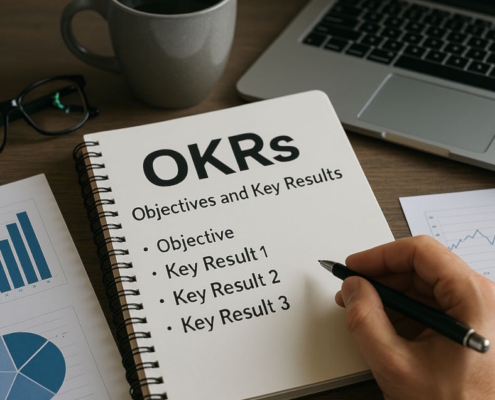KPIs (Key Performance Indicators): What are they?
KPI meaning refers to Key performance indicators which are measurable metrics that are used to assess the overall long-term success of a business. To monitor their progress toward important business goals, organizations employ KPIs.
When compared to other companies in the same industry, KPIs are particularly useful in assessing a company’s operational, financial, and strategic accomplishments. They may additionally be employed to evaluate growth or accomplishments in relation to a set of standards or prior results.
Important Takeaways
- Key performance indicators, or KPIs, compare a company’s performance to a set of goals, targets, or competitors in the same industry.
- Financial KPIs include the current ratio (cash and liquidity availability), revenues less specific expenses, and net profit (also known as the bottom line or net income).
- Client satisfaction, client retention, and per-customer effectiveness are typically at the heart of client-focused KPIs.
- The goal of process-focused KPIs is to track and evaluate operational performance throughout the company.
- KPIs are typically measured and monitored by businesses using reporting tools and analytics software.
Key Performance Indicators (KPIs): Why they are important
To assess performance and track advancement toward certain, quantifiable objectives, businesses utilize key performance indicators. They therefore give managers and owners a summary of how their company, or a particular part of it, is doing at a given moment. They are comparable to:
- A fixed standard
- Other industry rivals
- The business’s long-term performance
According to performance standards, KPIs, also known as KSIs (key success indicators), differ between businesses and industries. For instance, YOY (year-over-year) revenue growth could be the primary performance metric for a software company looking to achieve the quickest growth in its sector. On the other hand, a retail chain may consider identical-store sales to be the most valuable KPI measure for assessing growth.
KPIs rely on the gathering, storing, cleaning, and synthesis of this data. Data from KPIs is collected and compared to the predetermined goal. The comparison’s outcomes are then examined and used to make judgments regarding how well the department’s or company’s objectives are being met by the systems that are in place or have recently been modified. Understanding the KPI meaning enables management to determine if the present processes are working well or if adjustments are necessary to enhance those results and achieve future objectives.
KPIs are designed to provide management with concise results so they may make better strategic decisions. Reporting tools and analytics software are frequently used to measure them.
Fact: The data from KPIs can be either non-financial or financial, and they can be related to any department within an organization or the overall performance of the firm.
KPIs can be used at three different levels by businesses.
1. Company
The entire performance and health of the firm are the main focus of company-wide KPIs. Management can benefit from knowing how operations are going overall with the help of these KPIs. But frequently, they lack the specificity necessary to draw judgments. Conversations about the reasons behind the success or failure of particular departments are sometimes sparked by company-wide KPIs.
2. Departments
More detailed than company-wide KPIs, department-level KPIs frequently reveal the reasons behind certain results. Businesses routinely examine department-level KPIs in order to have a deeper understanding of the outcomes of company-wide KPIs. For instance, if total income is declining, a business might wish to examine customer happiness or conversion rates in particular divisions.
3. Sub-Department or Project
If a business wants to go any farther, it might use KPIs at the project or sub-department levels. These KPIs often have to be sought by management because they may call for highly specialized data sets that aren’t always easily accessible. For instance, while considering a possible product rollout, management could want to consult a control group.
How to establish KPIs (Key Performance Indicators)
Key performance indicators should be developed by an organization and matched with its objectives and results. In other words, the KPIs shall be unique to the company and not just a set of generic guidelines. The following are some things to take into account when establishing KPIs.
- Set specific goals: KPIs must be linked to a primary business aim that is related to the performance of the company, whether that target is marketing, customer service, financial, or something else. Decide how success will be measured and make sure that everyone understands it. An organization may lose time and important resources if certain procedures are not followed, leading to outcomes that fall short of its intended objectives.
- Share the KPIs: It is essential to share the organization’s KPIs with employees, elucidating the significance of the objectives and the measures that will be taken to attain them. For the key performance indicators to be significant, it is necessary to answer the important questions and issues that employees may have.
- Assess your KPIs: Making sure your KPIs are up-to-date and pertinent should be facilitated by regular reviews. The business environment is always changing, so you might need to modify your KPIs in response to how well the firm is performing as well as how its demands alter over time.
Metrics vs. KPIs
The quantitative evaluations of corporate objectives that depend on metrics are known as key performance indicators. Metrics are used to monitor certain company or departmental operations and procedures.
Common Key Performance Indicator Types
The majority of KPIs may be divided into four main groups. Every category has unique features, time periods, and business levels that are likely to employ it. Various departments inside the same company may also utilize distinct KPIs.
1. Strategic
Typically, strategic KPIs are the highest level. These KPIs only offer a high-level overview of a company’s performance, but they may show how it is going.
The most likely users of strategic KPIs are executives. Total business revenue, profit margin, and return on investment are a few examples.
2. Operational
Operational KPIs are time-sensitive. By examining various processes, market niches, or geographic areas, these KPIs assess a company’s performance month on month, or occasionally day over day.
Managers frequently utilize operational KPIs to investigate questions that arise from examining strategic KPIs. For instance, an executive might look into what lines of products are having trouble if they observe a decline in company-wide sales.
3. Functional
Within an organization, functional KPIs focus on particular divisions or roles. The number of new vendors that are registered each month in the finance department’s accounting information system, for instance, might be monitored. A marketing department tracks the number of clicks on each email distribution.
These KPIs might be either operational or strategic. What distinguishes them is that they offer the most benefit to a certain user group.
4. Lagging/Leading
Leading/lagging key performance indicators explain the type of data being examined and whether it shows an impending event or one that has already happened. Future changes are signaled by leading KPIs. KPIs that are lagging show that a shift has already occurred.
A flagship product’s profit margin and the number of overtime hours done are two examples. Should the business start noticing lower manufacturing quality, the number of overtime hours spent might be a leading KPI. Or, as a consequence of operations, profit margins are regarded as a lagging indicator.
KPIs that are frequently used
1. Financial Metrics
The financials’ key performance metrics usually center on revenue & profit margins. The most well-known and reliable profit-based metric is net profit, which is the amount of income left over as profit for a specific time period after all fees, taxes, & interest payments for that time period have been deducted.
The financial statements of an organization can be used to derive financial metrics. However, examining other figures that are more focused on evaluating the issues or facets of the business that management wants to investigate could be more beneficial to internal management. A business might, for instance, use variable costing for recalculating certain account balances solely for internal analysis.
Among the financial KPI examples are:
- Liquidity ratios: Indicators that gauge how effectively a business will handle its short-term debt commitments given its available short-term assets. Divide present assets by present liabilities to get what is commonly referred to as current ratios.
- Profitability ratios: Indicators that assess how well a business is doing at making sales while controlling costs. The margin of net profit is one example.
- Solvency ratios: Indicators that assess the financial stability of a business over time by determining its capacity to settle long-term debt. The ratio of overall debt to overall assets is one example.
- Turnover ratios: Key performance indicators that gauge how fast a business can complete a task. For instance, inventory turnover quantifies the speed at which a business may change an item from stock into a sale. Businesses aim to boost turnover in order to provide a quicker conversion of spending funds into revenue.
2. Metrics for the customer experience
Customer retention, customer satisfaction, and per-customer efficiency are typically at the heart of customer-focused KPIs. Customer support teams use these indicators to gain a better understanding of the services their clients have been getting.
The following are some examples of customer-focused metrics:
- New ticket requests: Determines the quantity of open and new problems that customers are experiencing by tallying customer support requests.
- Number of tickets resolved: Indicates how many requests have been handled satisfactorily. A business can determine how well it handles client requests by comparing the amount of requests with the total amount of resolutions.
- Average solution time: How long does it often take to assist the consumer regarding a problem? For example, companies may decide to separate the average resolution time for technical issue queries from requests for new accounts.
- Average reply time: How long does it often take a customer support representative to get in touch with a client after they have made a request? Even though the first agent could lack the skills or experience to offer a solution, a business might prioritize cutting down on the amount of time a client must wait for assistance.
- Best service agent: Any combination of the aforementioned metrics that customer service agents cross-reference. To identify the three quickest and slowest respondents, for instance, a corporation can also examine the average response time for everyone in the company.
- Request type: An inventory of the many request kinds. This KPI can assist a business in better understanding the issues that a client may be experiencing (for example, because the company’s website provided unclear or erroneous instructions) that the business has to address.
- Overall satisfaction rating: Although this is an ambiguous and imperfect metric, many businesses use surveys and post-interaction polls to obtain more information about the customer’s experience.
Important: Key performance indicators (KPIs) are internal measurements that management uses to assess a company’s performance; they are typically not needed by other parties.
3. Process Performance Indicators
The goal of process metrics is to gauge and track organizational operational performance. These KPIs examine task performance to determine whether process, quality, and performance problems exist or if changes need to be made.
For businesses with recurring processes, like manufacturing organizations or businesses in cyclical sectors, these measures are particularly helpful. Process performance measurements include the following examples:
- Production Efficiency: The production length of each step divided by the overall processing time is a common way to calculate this. For instance, a business can aim to solicit raw supplies only two percent of its time. The company is aware that it needs to enhance that area if it finds that it accounts for five percent of the entire process.
- Overall cycle time: How long does it take to finish a procedure from beginning to end? Management can convert this to mean cycle time if they want to examine the procedure over a longer time frame.
- Throughput: The speed of the manufacturing procedure is determined by dividing the quantity of units produced by the manufacturing time per unit.
- Error rate: Dividing the overall number of errors by the total quantity of units manufactured. In an effort to cut waste, a business can use this indicator to determine how many products are failing to pass quality testing.
- Quality rate: A percentage of manufactured goods that pass quality assurance inspections. This percentage tells management how well it is meeting quality standards by dividing the number of successful units finished by the overall quantity of units produced.
4. Marketing Metrics
Marketing KPIs aim to improve understanding of the effectiveness of advertising and marketing campaigns. In response to a particular marketing medium, these metrics frequently gauge conversation rates or the frequency with which potential customers take specific actions. Marketing KPIs involve, for example:
- Website traffic: This KPI meaning signifies the number of users who access particular sections of the website of a company. With the usage of this KPI, management can gain a better understanding of whether users are being routed effectively and whether internet traffic is being forced along prospective sales routes.
- Social Media traffic: Keeps track of the engagement, likes, shares, retweets, views, followers, and other quantifiable interactions that take place between the business’s social media pages and its customers.
- Call-to-action content conversion rate: This KPI meaning indicates how well marketing campaigns persuade consumers to do specific activities, like buying something during a sale. The proportion of customers that responded to the call to action can be calculated by dividing the number of favorable engagements by the entire number of content dissemination.
- Posts published: The quantity of print or blog articles that a business releases during a specific period of time, like a quarter or a month.
- Click-through rates: How many particular clicks are made on email deliveries? It is possible for programs to monitor the number of clients that opened a communication, clicked the link provided in the email, and completed a purchase after clicking on the link.
5. IT Metrics
To boost productivity and employee happiness, any department in a business can be made better. This KPI meaning covers the functioning of the internal technology department. The IT department’s staffing level can be determined by these KPIs. IT KPIs include, for example:
- Total downtime of the system: The duration of time required to bring different systems offline for maintenance or updates. Customers might not be able to place purchases or staff members might not be able to do specific tasks when systems are down, which could hinder operations and degrade customer service.
- Number of resolutions/tickets: The handling of tickets pertaining to internal employee requests, including those for software or hardware, network issues, or other internal technological issues. This is comparable to KPIs for customer service.
- Number of features developed: To gauge internal product development, count the amount of product modifications made to internal applications or systems.
- Critical bug count: The number of serious issues with programs or systems. A business must establish internal guidelines for determining what bugs are considered minor and major.
- Backup frequency: The regularity with which important data is copied and kept in a secure location. Depending on archived record standards, management can establish different goals for different pieces of information.
6. Sales Metrics
Making money from sales is a company’s ultimate objective. Sales KPIs use non-financial data to gain a deeper understanding of the sales process, whereas revenue is often monitored using financial KPIs. Sales KPIs include, for example:
- CLV (Customer lifetime value): This KPI meaning signifies the amount of dollars that a client will likely spend on the products you sell during the course of the business partnership.
- CAC (Customer acquisition cost): The sum of the marketing and sales expenses needed to acquire a new client. By contrasting CAC with CLV, companies can assess how well their customer acquisition initiatives are working.
- New contracts’ mean dollar value: This KPI meaning highlights the typical size of new deals. A corporation may set a target threshold for attracting either smaller or larger clients.
- Average time to convert: The duration between reaching out to a potential customer and obtaining an agreement to conduct business.
- Number of leads that are actively involved: The number of prospective leads that were contacted. This number can be further broken down into channels like meetings, phone calls, emails, and other interactions with clients.
Quick fact: Bonuses may be linked to KPIs by management. Depending on whether salespeople generate a sufficient number of leads or achieve desired conversion rates, their compensation rate may vary.
7. Metrics of Human Resources and Staffing
Employers may also benefit from examining KPIs unique to their workforce. Regarding employee satisfaction, retention, and turnover, a business often has a lot of data on hand. Human resource and staffing KPIs include, for example:
- Absenteeism rate: This KPI can be used to help managers prepare for seasonal staffing variance, such as periods of the year when workers have a greater probability to be sick, and track how many dates each year or specific periods employees have called out or missing shifts. It may also be a leading sign for disengaged or disgruntled employees.
- Number of additional hours worked: This metric is used to determine whether staffing levels are suitable or whether employees may be experiencing burnout.
- Employee satisfaction: An assessment of workers’ opinions regarding several facets of the business, usually done through surveys. Employing the same questionnaires each year to monitor changes from year to year will help businesses get the most out of this KPI.
- Turnover rate: The rate at which workers are quitting their jobs. Businesses can further analyze this KPI across teams or departments to find out why certain positions might be leaving more quickly than others.
- Number of job candidates: The number of applications received for available positions. With the use of this KPI, employers may determine whether job postings are reaching a large enough audience to generate interest and draw in qualified applicants.
How to put together a KPI Report
Sorting through a company’s massive data collection and identifying the KPIs that are most relevant and influential for decision-making can be challenging. Take into account the following actions while starting to compile KPI dashboards and reports:
- Decide on objectives and plans. KPIs are just as good as their users think they are. Choose the KPIs that can assist you achieve your goals after you have set clear objectives before creating any KPI reports.
- Draft specifications for SMART KPIs. Unrealistic, ambiguous, and difficult to determine KPIs are of little to no use. Rather, concentrate on the information that is easily accessible and SMART (specific, measurable, achievable, realistic, and time-bound).
- Have flexibility. Be ready for additional focus to be placed on other areas and for new business issues to surface as you compile KPI reports. Numbers, measures, and objectives should all be adjusted to reflect operational changes as business and consumer needs evolve.
- Users shouldn’t be overloaded. It could be tempting to include as numerous KPIs as possible in a report, overwhelming report users. When KPIs reach a certain level of complexity, it can be challenging to understand them and to decide which measures should be prioritized. If required, prepare distinct reports that are each centered on a particular issue or objective.
Tip: When creating KPI reports, begin by displaying the most comprehensive data (i.e., total sales for the company). A lower level of information (i.e., revenue by division, followed by revenue by division and product) should then be displayed.
The benefits of using key performance indicators
A business might want to look at KPIs for a number of reasons.
- Encourage measurable goals: Understanding your objectives is essential to efficiently tracking and evaluating KPIs. This can motivate companies to establish clear, attainable objectives and design systems that support achieving them, as opposed to developing systems without understanding their intended use.
- Information-driven solutions: KPIs assist in informing management about particular issues and identifying solutions. When it comes to strategic planning and maintaining excellence in operation, the data-driven strategy offers measurable facts.
- Increased accountability: KPIs aid in holding staff members responsible. KPIs are empirically backed and can’t discriminate among employees, unlike sentiments or emotions. When properly implemented, KPIs can motivate staff members by making them aware that their performance is being closely watched.
- Assess progress: KPIs link corporate objectives to real-world activities. A corporation may create goals, but those plans serve little to no benefit if they cannot be tracked. KPIs give businesses the ability to set goals and track their success.
Key performance indicators’ limitations
Some drawbacks to using KPIs should be taken into account.
- Time commitment: KPIs may need a considerable amount of time to produce useful data. For instance, to gain a better understanding of patterns in employee satisfaction, a business might need to gather yearly data from staff members over the years.
- Need frequent follow-up: In order for KPIs to be effective, they need to be closely monitored and closely followed up on. There is no point in creating a KPI analysis that is never examined. Furthermore, useful decision-making is not promoted by KPIs that are not regularly checked for accuracy and appropriateness.
- Manipulation possibilities: KPIs give managers the ability to “game” them. The improvement of KPIs linked to performance bonuses may feel more motivating to managers than genuinely changing procedures or outcomes.
- The danger of improper incentive: Quality may suffer if management appears to be more concerned with metrics than with real outcomes because they are overly preoccupied with productivity KPIs. Moreover, workers could feel under pressure to achieve unreasonable KPI metrics.
KPI meaning
Key performance indicators, or KPIs, are summaries of data that have been gathered, examined, and compiled to aid in business decision-making. An example of a KPI might be “450 revenues in October,” which is a single figure or computation that sums up a period of action. KPIs are useless for a business on their own. A firm can, however, use this data to make better decisions about operations and strategy by comparing KPIs to predetermined standards, such as organizational targets or a competitor’s performance.
Which 5 KPIs are the most often used?
KPI meaning differs depending on the company, and some KPIs are better suited for particular businesses than others. There are five key performance indicators that are frequently employed in a wide range of businesses:
- Increase in revenue
- Earnings per customer
- The margin of profit
- Retention rate of clients
- Client satisfaction
What qualifies as a good KPI?
A quality KPI meaning relates to unbiased, understandable data on how well an end goal is being achieved. It offers a method to gauge performance over a period of time and tracks and evaluates elements including effectiveness, timeliness, quality, and performance. A KPI’s ultimate objective is to assist management in making wise choices.
Bottom Line
KPIs are measurements that companies monitor and evaluate in order to comprehend performance and achieve measurable objectives. Sales, marketing, process, customer service, and financial indicators are examples of KPIs that are frequently utilized.
Managers are more equipped to optimize the firm for its future success when they understand the KPI’s meaning and the best way to use them correctly.






























